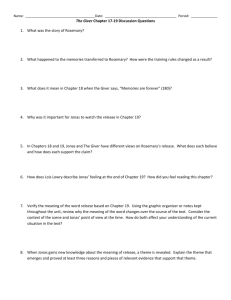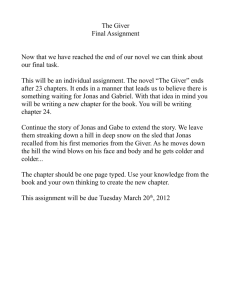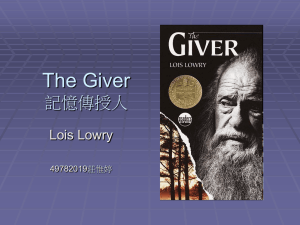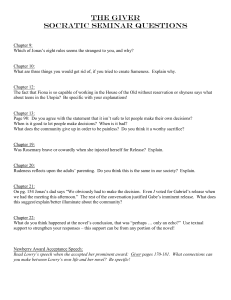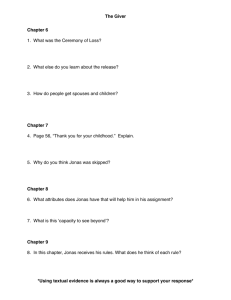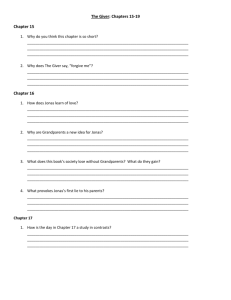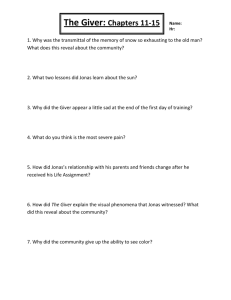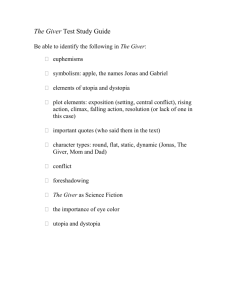Grade 7 ESL Mini Unit - Inwood Intermediate School 52
advertisement
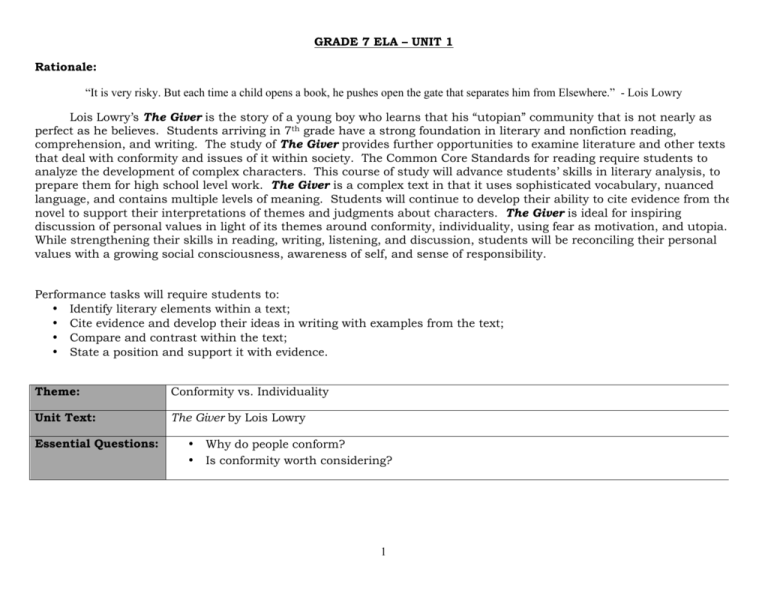
GRADE 7 ELA – UNIT 1 Rationale: “It is very risky. But each time a child opens a book, he pushes open the gate that separates him from Elsewhere.” - Lois Lowry Lois Lowry’s The Giver is the story of a young boy who learns that his “utopian” community that is not nearly as perfect as he believes. Students arriving in 7th grade have a strong foundation in literary and nonfiction reading, comprehension, and writing. The study of The Giver provides further opportunities to examine literature and other texts that deal with conformity and issues of it within society. The Common Core Standards for reading require students to analyze the development of complex characters. This course of study will advance students’ skills in literary analysis, to prepare them for high school level work. The Giver is a complex text in that it uses sophisticated vocabulary, nuanced language, and contains multiple levels of meaning. Students will continue to develop their ability to cite evidence from the novel to support their interpretations of themes and judgments about characters. The Giver is ideal for inspiring discussion of personal values in light of its themes around conformity, individuality, using fear as motivation, and utopia. While strengthening their skills in reading, writing, listening, and discussion, students will be reconciling their personal values with a growing social consciousness, awareness of self, and sense of responsibility. Performance tasks will require students to: • Identify literary elements within a text; • Cite evidence and develop their ideas in writing with examples from the text; • Compare and contrast within the text; • State a position and support it with evidence. Theme: Conformity vs. Individuality Unit Text: The Giver by Lois Lowry Essential Questions: • • Why do people conform? Is conformity worth considering? 1 Chapters 1-4 Overview: The first four chapters of The Giver introduce students to Jonas and provide a basic understanding of his family, community, and the rules used to make his community “ideal”. Readers learn of the specific roles within the community, such as Nurtures, Birthmothers, Recreation Director, Caretakers, as well as how family units are formed. These chapters are also an opportunity to teach students about genre and point-of-view, discussion techniques & weekly journal entries, and to explore Essential Questions. Essential Questions: Why do people conform? Is conformity worth considering? Example1: Students first respond to the EQ individually in writing. They will then have an opportunity to revisit their response before a whole group discussion. Reader Response Journals: The Reader Response Journals are a place for students to: • respond to text in writing • record personal reactions to text • generate questions • dialogue with a peer • brainstorm and draft for Assessment Tasks What is close reading? Close Reading: Begins with an independent read during which students may or may not use annotation strategies that have been pretaught, based on student readiness. Length or amount of text may be differentiated. An independent reading is followed by a teacher-led or peer-led read aloud. Discussion questions are revealed to students prior to the read-aloud, so that students are engaging in a second read with questions in mind. >>Discussion Supports Writing: After the read-aloud, students discuss the passage or text within their group and the group generates responses to the discussion questions. Students then produce written responses to the discussion questions. Discussion questions may differ from group to group, but always support the written task. 1 Teachers may choose to explore EQs with students through individual or group written opportunities and/or through group discussion. This is one example. 2 Chapters 1-4 Instructional Questions Ø How can an author’s experiences inspire his / her writing? Ø What is conformity? Ø Why do people conform? (EQ) Ø What are the benefits / drawbacks of conformity? Ø Is conformity worth considering? (EQ) Ø What makes a utopian society perfect? Ø How does an author use word choice to develop setting and character? Learning Activities Ø Shared Reading: Students will engage in a shared reading experience with short biography excerpts of Lois Lowry. While building understanding of Lois Lowry’s background, students will also explore the purpose of multiple readings of a text, as well as begin to engage in group discussions that support comprehension. Ø Small Group Discussion: After responding to the EQ in writing, students will then discuss their responses, as well as the responses of their peers, to the EQ in groups. Ø Think Pair Share: After viewing clips from the movie version of Fahrenheit 451, students will compare and contrast the setting with The Giver. Supplemental Texts / Resources: Ø Excerpts from Looking Back by Lois Lowry: 1949, 1972 and 1973 Ø Utopia Power Point Ø Fahrenheit 451 by Ray Bradbury – movie version Tasks Ø Anticipation Guide (pre-reading) Ø Compare/contrast settings between The Giver and Fahrenheit 451 (movie) Ø Quiz: Chapters 1-4 Ø Chapter Focus Questions: • What is the significance of Jonas’s attention to careful, accurate language? (Ch. 1) • How does Lois Lowry’s use of unusual vocabulary for familiar objects contribute to setting? (Ch. 2) (e.g., dwelling = house, tunic = shirt) • In what way are differences treated in the community? (Ch. 3) • In what areas of life do the members of the community have free choice, and in what areas are their lives regulated? (Ch.4) Ø Reader Response Journal: Rules Do rules make life easier, or harder? What are the important rules that affect your life the most? Why do we have rules, if it is our human right to be free? Think about The Giver, too. Are their rules good or not? 3 Standards RL 7.3 Analyze how particular elements of a story or drama interact (e.g., how setting shapes the characters or plot). RL 7.4 Determine the meaning of words and phrases as they are used in a text, including figurative and connotative meanings; … Vocabulary: conformity, utopia, setting, mood, evidence, purpose, inference/infer, connotation/denotation Scaffolds / Support Ø Paired and group discussions Ø Paired Reading Ø Picture Book – The Giver – Chapters 1-4 Chapters 5 - 8 Overview: In Chapters 5 - 8 readers begin to learn of the dream telling ritual and how the community deals with rise of emotions within its young members. The reader also learns about the ceremonies that take place each year and the symbolism of the ceremony for each age group. Jonas is selected as Receiver of Memory. These chapters also allow for students to begin understanding character and character traits. Assessment Task 1: Reread Jonas’s acceptance as the next Receiver of Memory on page 64. Compare and contrast it to the naming of the new child, Caleb, on page 44. Chapters 5 - 8 Instructional Questions Ø How does conformity influence society? Ø How can being different be terrifying and empowering at the same time? Ø How can an author’s use of symbols deepen a reader’s understanding of a text? Ø How do our five senses contribute to memory and individuality? Learning Activities Ø Think Pair Share: Character analysis (including major vs. minor and static vs. dynamic) – Students work with a partner to analyze two characters from the novel – one a dynamic and the other a static character. Students work together to complete a character analysis graphic organizer. Ø Gallery Walk: Students exhibit and share work via a gallery walk for feedback and sharing. Ø Close Reading: Preparation for Assessment Task 1 – page 44 and page 64. Ø Small Group Discussion: How do our five senses contribute to memory and individuality? Ø RAFT Activity: Students choose individual project to complete responding to the December Ceremony. Supplemental Texts / Resources: Character analysis graphic organizer Symbols/Community Life Schedule Standards RL 7.3 Analyze how particular elements of a story or drama interact (e.g., how setting shapes the characters or plot). SL7.1 Engage effectively in a range of collaborative discussions (one-on-one, in groups, and teacher-led) with diverse partners on grade 7 topics, texts, and issues, building on others’ ideas and expressing their own clearly. Vocabulary: symbolism, foreshadowing, character analysis, dynamic, static (major/minor) Tasks Ø Character analysis graphic organizer Ø Symbols worksheet/Community Life Schedule Ø RAFT Activity – December Ceremony Ø Quiz – Chapters 5-8 Scaffolds / Support Ø T-Charts /Chunk text for students to read independently with greater success. Ø Provide a focus and text-based vocabulary for each chunk. 4 Ø Chapter Focus Questions: Ø What is the purpose of the dream-telling ritual? (Ch. 5) Ø How does the pledge the family has to sign about Gabriel serve as a symbol of the community’s beliefs? (Ch. 6) Ø How would you characterize the Chief Elder? (Ch. 7) Ø What is unusual about the Receiver? What might this foreshadow for his place within the community? (Ch. 8) Ø Reader Response Journal: Memories 1. First, imagine there is a Memory Department Store--a place where you can buy, sell trade and repair memories. For your journal, design an advertisement for this memory store highlighting a happy memory and a sad memory. Use a piece of unlined paper. The advertisement should have both words and pictures. 2. Describe the 2 memories you chose to advertise in the above response. Describe each memory with words and describe why it is happy or sad. Then try to imagine what your life would be like without that memory. Which of the two had a greater impact on who you are today? 5 Ø Picture Book – The Giver – Chapters 5-8 Ø Character analysis graphic organizer Ø Symbols worksheet/Community Life Schedule Chapters 9 - 14 Overview: In chapters 9 – 14 Jonas begins to understand his role as Receiver of Memory and the purpose of this role within his community. He starts to experience memories, most of which are pleasant up to this point. These memories begin to impact Jonas’s perceptions of the world around him and he begins to question his society. Assessment Task 2: In a short response, contrast Jonas’s point of view before becoming Receiver of Memory to after becoming Receiver of Memory. Cite evidence from the text to support your response. Chapters 9 - 14 Instructional Questions Ø How can being different be terrifying and empowering at the same time? Ø How does an omniscient narrator impact the telling of a story? Ø How can an author’s use of symbols deepen a readers understanding of a text? Learning Activities Ø Think Pair Share: Students will discuss the point of view from which the story is told by looking for clues that lead them to their response. Ø Shared Reading/Jigsaw Reading: Students will be broken up into small groups. Longer, more challenging nonfiction articles on conformity will be divided among the groups to increase engagement and comprehension. Ø Socratic Seminar: “How can being different be terrifying and empowering at the same time?” Standards RL 7.1 Cite textual evidence to support analysis of what the text says explicitly as well as inferences drawn from the text. SL7.1 Engage effectively in a range of collaborative discussions (one-on-one, in groups, and teacher-led) with diverse partners on grade 7 topics, texts, and issues, building on others’ ideas and expressing their own clearly. RL 7.6 Analyze how an author develops and contrasts the points of view of different characters or narrators in a text. RI 7.9 Analyze how two or more authors writing about the same topic shape their presentations of key information by emphasizing different evidence or advancing different interpretations of facts. 6 Supplemental Texts / Resources: What is Socratic Seminar? How to Prepare for a Socratic Seminar Voices in the Park by Anthony Browne Nonfiction articles on memory Excerpts from Lois Lowry’s Newberry Acceptance Speech 1994 Vocabulary: point of view, omniscient/limited, symbols, conflict (internal/external) Tasks: Ø Assessment Task 2 Ø Socratic Seminar Ø Quiz Chapters 9-14 Ø Chapter Focus Questions: • Jonas thinks, “Things couldn’t change with Asher” (pg. 66). Is he right? Support your answer with evidence from the text. (Ch. 9) • How does the Receiver treat Jonas? (Ch. 10) • Which senses are involved in Jonas’s perception of the memories? (Ch. 11) • What discovery is Jonas making about language and communication? (Ch. 12) • What does it mean that Jonas’s life id no longer ordinary? (Ch. 13) • How did Jonas feel about giving Gabriel a memory? (Ch. 14) Ø Journal Responses: Sameness/Diversity (Choice) 1. Write about Sameness as it exists in our school or community. Write about the dress and behaviors of different groups you know of. Think of popular clothing, haircuts, ways of talking, etc. It sometimes seems like people go through ceremonies to get the same styles. Are people afraid to be different? 2. What advantages might “sameness” produce for contemporary societies? In what ways do your differences make us distinctly human? Is loss of diversity worthwhile? 3. Each member of society should be assigned an occupation consistent with his or her individual skills to prevent unemployment, job dissatisfaction, and inefficiency. Write one paragraph explaining whether you agree or disagree with this statement. 7 Scaffolds / Support Ø T-Charts – Chunking text Ø Picture Book – The Giver – Chapter 9 Ø Partner Reading Chapters 15 - 18 Overview: In chapters 15 – 18 Jonas learns what pain and death are. He feels compassion for The Giver and others for the first time. Jonas begins to realize that he will forever be apart from his friends and family because of the memories he has acquired. He also begins to ask questions regarding his predecessor, Rosemary and her release. He begins to understand the magnitude of his role in his community. Assessment Task 3: After reading in Chapters 10-15 how Jonas begins to receive memories of pain, suffering, and war along with the more pleasurable memories of color, sunshine, and snow, consider the following question: Is Jonas’s Assignment as the Receiver of Memory an honor or a burden? Respond in one well-developed paragraph, stating your claim, using textual evidence to support your claim. Instructional Questions Ø Why are memories important? Ø Why is history important? Ø Does the knowledge of history and memories lead to wisdom? Ø How can knowledge of history affect our present and future? Learning Activities • Close Reading: Students will engage in a close reading experience with Chapter 15 in preparation for Assessment Task #3. Ø Shared Reading/Jigsaw Reading: Students will be broken up into small groups. Longer, more challenging nonfiction articles on the importance of history will be divided among the groups to increase engagement and comprehension. Standards RL.7.1 Cite textual evidence to support analysis of what the text says explicitly as well as inferences drawn from the text RL 7.2 Determine a theme or central idea of a text and analyze its development over the course of the text; provide an objective summary of the text. RL 7.9 Compare and contrast a fictional portrayal of a time, place, or character and a historical account of the same period as a means of understanding how authors of fiction use or alter history. Supplemental Texts / Resources Civil War Powerpoint Excerpt from: The Journal of Rufus Rowe, Witness to the Battle of Fredericksburg (A Dear America Series) Nonfiction reading – “The Importance of History” 8 Vocabulary: theme, Civil War language: rebel, Yank(ee), Confederate, Union, Tasks Ø Assessment Task 3 Ø Quiz Chapters 15-18 Ø Chapter Focus Questions • How is Jonas now a Giver? (Ch. 15) • What memory represents the theme that in order to appreciate pleasure, one must also have pain? Why does Jonas go back to the Giver? (Ch. 16) • What changes have the memories brought about in Jonas? (Ch. 17) • Contrast The Giver’s feelings for Jonas with Mother’s and Father’s feelings for Jonas. (Ch. 18) Ø Reader Response Journal: Families 1. Parents should have to apply for children to prevent burdening society with children whose parents are unprepared, unwilling or unable to care for and nurture productive members of society. Write one paragraph explaining whether you agree or disagree with this statement. Be sure to make connections to what is happening in our present day society. 2. The families in The Giver do not live with (or know about) their grandparents. Describe your family make up as compared to the family units in the book. What are the benefits and/or drawbacks to living with the older generation? 9 Scaffolds / Support Ø Civil War Powerpoint – to provide background knowledge to students Ø T-Charts – Chunking text Chapters 19 - 20 Overview: Jonas learns the truth about release and the community members’ roles in the process. He feels betrayed by his family and friends and their lack of understanding of what they are doing. Jonas wants to withdraw from his family and the community, The Giver has a plan to help Jonas and help the community change. Instructional Questions How does the theme of euthanasia connect to the idea of individuality vs. conformity? Is euthanasia ever justifiable? Is the world of the Giver, a utopia or dystopia? Learning Activities o Ø Shared Reading/Jigsaw Reading: Students will be broken up into small groups. Longer, more challenging nonfiction articles on euthanasia/ mercy killings will be divided among the groups to increase o engagement and comprehension. Ø Socratic Seminar – Should euthanasia (mercy killings) be legalized in this country? Is euthanasia ever justifiable? o Ø Costa’s Levels of Questioning o Supplemental Texts / Resources: Nonfiction readings on euthanasia “Harrison Bergeron” by Kurt Vonnegut (extension for more advanced readers) Tasks Ø 4 Step Response to Quote Ø Socratic Seminar Ø Chapter Focus Questions • What foreshadows the knowledge Jonas receives in this chapter? (Ch. 19) • Why can Jonas lie easily now? (Ch. 20) 10 Standards SL 7.1a Come to discussions prepared, having read or researched material under study; explicitly draw on that preparation by referring to evidence on the topic, text, or issue to probe and reflect on ideas under discussion. SL.7.1b Follow rules for collegial discussions, track progress toward specific goals and deadlines, and define individual roles as needed. SL.7.1c Pose questions that elicit elaboration and respond to others’ questions and comments with relevant observations and ideas that bring the discussion back on topic as needed. SL.7.1d Acknowledge new information expressed by others and, when warranted, modify their own views. Vocabulary: euthanasia, mercy killing, utopia/dystopia, justifiable Scaffolds / Support Jigsaw/small group reading and discussion. Chapters 21 - 23 Overview: In chapters 21 – 23 Jonas has to flee the community before the time he and The Giver had planned on because Jonas learns that Gabriel is going to be released. The community sends search planes after them and Jonas and Gabriel must hide so they will not be found. Jonas and Gabriel must struggle through nature and the elements in order to survive. The lack of food and nourishment finally takes a toll on them and their survival hangs in the balance. Instructional Questions Learning Activities Standards Ø What questions did Lois Lowry leave unanswered at the end of the book? Ø What are the possible interpretations of the end of this book? Ø Why would an author leave an ending open to interpretation? Ø Think Pair Share: Students will discuss their interpretations of the ending of the book, looking at the evidence from Chapter 23 that supports their reasoning. Ø Guided Reading – “The Moth” by Don Marquis – Teacher will conduct guided reading of the poem for the whole group. Ø Paired Reading/Small Group Discussion – Students will work with a partner to look at comparisons/contrasts of the novel to the poem and to clips from the movie Pleasantville. RL 7.1 Cite several pieces of textual evidence to support analysis of what the text says explicitly as well as inferences drawn from the text. SL 7.2 Analyze the main ideas and supporting details presented in diverse media and formats (e.g., visually, quantitatively, orally) and explain how the ideas clarify a topic, text, or issue under study. RL 7.5 Analyze how a drama’s or poem’s form or structure (e.g., soliloquy, sonnet) contributes to its meaning Supplemental Texts / Resources: “The Moth” by Don Marquis Pleasantville – the movie Vocabulary: interpretation, ambiguous, incongruent 11 Tasks Ø Unit Test Ø Summative Task Scaffolds / Support Pleasantville – movie clips Paired Reading Ø Chapter Focus Questions • How does the description of Jonas’s evening meal with his family contrast with the description of Jonas’s escape? (Ch. 21) • What incongruous feeling did Jonas have on pages 171-172? (Ch. 22) • How does the content of Jonas’s memories change as he approaches the summit of the hill? (Ch. 23) Summative Task: The ending of the novel is seen as ambiguous: having more than one interpretation. It could be argued that Jonas died at the end of the novel or he survived and went on to another community. Explain which you feel is the correct interpretation. Provide evidence from the text to support your ideas. 12
